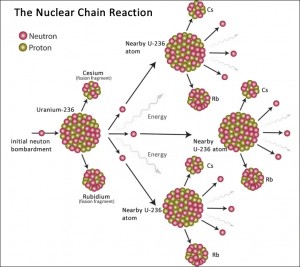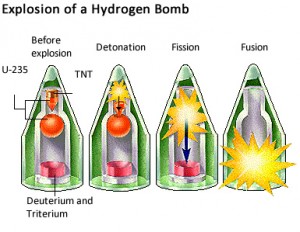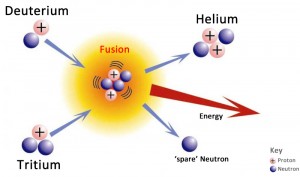How does a Nuclear Bomb work ?
What is a Nuclear Bomb ?
Nuclear bombs work by initiating a nuclear chain reaction releasing the huge amounts of energy that is tied up in holding the nucleus or centre of atoms together. Relative to conventional explosives nuclear bombs can be of the order of millions to billions of times more powerful than TNT.
There are two main types of bombs which release energy from the nuclei of atoms.
- The atomic bomb or Fission bomb – Like nuclear power stations, it releases great quantities of energy through a process called nuclear fission, or ‘splitting’, of a large unstable (radioactive) elements like uranium or plutonium.
- The hydrogen bomb or thermonuclear bomb – Thermonuclear devices release even greater quantities of energy through nuclear fusion.
1. The Atomic Bomb or Fission bomb
Nuclear Reactions
Nuclear reactions occur when elements, such as uranium or plutonium isotopes, with heavy nuclei break apart into lighter nuclei. They do this when they’re hit by another sub-atomic particle called a neutron. The breaking apart of a nucleus as well as creating new nuclei also release more ‘free’ neutrons which in turn bombard other nuclei, creating a chain reaction. This process is known as fission. (An alternate process known as fusion releases energy by fusing together nuclei rather than breaking them apart… see Fusion Bombs below). This all occurs naturally and is what makes certain elements radioactive.
In radioactive substances their atoms are constantly ‘falling apart’, breaking up into smaller elements that are more stable. So radioactive substances will eventually transmute into another completely different substance as it’s atoms break down. For example a Uranium 236 atom breaks down to form two new atoms: Cesium and Rubidium. Every time one nucleus does breaks it also releases the extra energy it no longer needs to hold it together, as well as a few left-over neutrons. This energy, and the escaping neutrons, is what we is described as the ‘radiation’ from a radioactive substance. This energy and flow of escaping neutrons can damage human cells, which is what makes radioactivity so dangerous.
Enough atoms in the chunk of plutonium are breaking down at any one time to make the chunk of plutonium warm up, but not enough to be cause an explosion.
Using Fission to Create a Bomb
To create a bomb therefore, this natural radioactive breakdown needs to be drastically sppeded up. Accordingly, in a fusion bomb, a radioactive substance, such as Plutonium, is surround by TNT. The force of the TNT explosion causes the plutonium to be squashed, or compressed in size, and become very dense. This is called its ‘critical mass’; the plutonium is now so densely packed together that the neutrons escaping from the decaying nuclei of plutonium cannot escape from the plutonium without hitting into another plutonium atom!. Thus a rapid escalating chain reaction is initiated so that the escaping neutrons that normally would fly out of the material now can’t, without hitting other nuclei!
Within a very tiny fraction of a second, all the nuclei in the chunk of plutonium have been hit by escaping neutrons, and have broken down. The extra energy in trillions of atomic nuclei is all released at once! This energy is considerable; the atomic bomb dropped on Hiroshima in WWII was an example of this process.
2. The Hydrogen Bomb (aka Thermonuclear or Fusion Bombs)
A Bomb inside a bomb
This is a much nastier bomb. Not only does it release much more energy, using a process called ‘nuclear fusion’, but it is triggered not by TNT, but by another atomic bomb!
The central core of a fusion bomb is a mass made up two kinds of atoms, both of which are isotopes of hydrogen, called deuterium and tritium. (These are just hydrogen atoms with one or two extra neutrons in each nucleus). Several small atomic bombs are then packed around the outside of this core. When they are detonated they cause the deuterium and tritium to be squeezed into a very dense mass, which initiates a process called nuclear fusion, releasing huge quantities of energy.
However there’s more! The outer casing of the bomb is made up of Uranium so as the core explodes, it causes the bomb casing to undergo fission(as described above), creating even more energy. So in other words, an atomic bomb sets off a fusion bomb, which also triggers another atomic bomb!
How Fusion in the Bomb Works
The block of deuterium and tritium atoms are squeezed into a super-dense mass by the exploding atomic triggers. Nuclei of these two isotopes are squeezed together by the force of the explosion.
The force is so great that it causes the nuclei to combine. This process is called nuclear fusion.
A new nucleus is formed and therfore a new element … helium.
The new Helium nucleus requires less energy to keep it together, plus there is one less neutron needed. This excess energy, and the neutron, escape as radiation.
The amount of escaping energy is huge; bombs of this type can release energy equivalent to the explosion of many millions of tons of TNT.
The escaping neutrons also cause the Uranium in the bomb casing to undergo a fission chain reaction, the energy from which is added to the total output of the bomb. It also results in much radioactive material being expelled into the atmosphere, which can later descend as ‘fallout’, and kill living things.
Bombs without the uranium casing just release a lot of energy and neutrons, killing in the immediate vicinity without leaving a lot of radioactive fallout. These ‘cleaner’ bombs are called neutron bombs.










You must be logged in to post a comment.